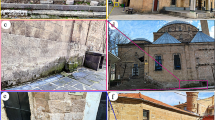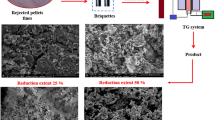Abstract
In this paper we study the effect of the structure of a composite diamond-containing material (CDM) with a metal binder (Ni–Sn) obtained by resistive electrosintering under pressure (up to 300 MPa) on the intensity of its wear when cutting sandstone from the Torez deposit. Using the experimental stand, the CDM elements were tested for wear resistance of diamond-containing functional elements with various degrees of diamond reinforcement. For the first time, the magnetic and morphometric characteristics of the collected destruction products of the Torez deposit sandstone and the wear of functional elements with CDM on a metal basis (sludge), which were obtained upon its separation in a magnetic field, were determined. It was determined that the sludge can be divided in a magnetic field into fractions that differ in specific magnetic susceptibility up to 153 times. The fraction with high specific magnetic susceptibility of (1500–9500) × 10–8 m3/kg is only 0.44–0.80 wt % of sludge while the fraction with specific magnetic susceptibility of (3.9–8.8) × 10–8 m3/kg is 96.06–97.99 wt %. Using X-ray fluorescence spectrometry in the sludge, the content of CDM binder particles was determined (from 0.120 to 0.741 wt %) depending on the distribution of the reinforcing diamond fraction on the operating surface of the functional element. A granulometric classification of sludge particles obtained by cutting rock was performed, based on which the size distributions of the projections of sludge particles were determined, and the medians of their size distributions vary from 17.35 to 57.18 µm depending on the degree of diamond reinforcement of the operating surface of the functional elements of rock cutting tools.






Similar content being viewed by others
REFERENCES
Aleksandrov, V.A., Obrabotka prirodnogo kamnya almaznym diskovym instrumentom (Processing of Natural Stone by a Diamond Disc Tool), Kiev: Naukova Dumka, 1979.
Zybinskii, P.V., Bogdanov, R.K., Zakora, A.P., and Isokin, A.M., Sverkhtverdye materialy v geologorazvedochnom burenii (Superhard Materials in Geological Exploration Drilling), Donetsk: Nord-Press, 2007.
Vovchanovskii, I.F., Porodorazrushayushchii instrument na osnove Slavuticha dlya bureniya glubokikh skvazhin (Rock Cutting Tool Based on Slavutych for Frilling Feep Wells), Kiev: Naukova Dumka, 1979.
Tsypin, N.V., Iznosostoikost’ kompozitsionnykh almazsoderzhashchikh materialov dlya burovogo instrumenta (Wear Resistance of Composite Diamond-Containing Materials for Drilling Tools), Kiev: Naukova Dumka, 1993.
Galitskii, V.N., Kurishchuk, A.V., and Murovskii, V.A., Almazno-abrazivnyi instrument na metallicheskikh svyazkakh dlya obrabotki tverdogo splava i stali (Diamond-Abrasive Tools on Metal Bonds for Processing Hard Alloy and Steel), Kiev: Naukova Dumka, 1986.
Bakul’, V.N., Bilyk, I.I., Bronshtein, D.Kh., Vovchanovskii, I.F., and Tsypin, N.V., USSR Certificate no. 514482, Byull. Izobret., 1979, no. 7.
Dr. Fritsch, Materials, machines and equipment for diamond technology, in Katalog produktsii firmy Dr. Fritsch (Dr. Fritsch Product’s Catalog), Moscow: DÜCK GmbH, 1999.
Huber, J., FAST/SPS brings sintering up to speed, Materialy 14 Mezhdunarodnoi nauchno-tekhnicheskoi konferentsii, posvyashchennoi 60-letiyu poroshkovoi metallurgii Belarusi “Novye materialy i tekhnologii: poroshkovaya metallurgiya, kompozitsionnye materialy, zashchitnye pokrytiya, svarka” (Proc. Fourteenth Int. Sci.-Tech. Conf. Dedicated to the 60th Anniversary of Powder Metallurgy in Belarus “Advanced Materials and Technologies: Powder Metallurgy, Composite Materials, Protective Coatings, and Welding”), Minsk, 2020, pp. 77–79.
Pereyaslov, V.P., Ivanov, S.A., and Maystrenko, A.L., UA Patent 20674A, 1997.
Maystrenko, A.L., Formirovanie struktury kompozitsionnykh almazsoderzhashchikh materialov v tekhnologicheskikh protsessakh (The Structure of Composite Diamond-Containing Materials in Technological Processes), Kyiv: Naukova Dumka, 2014.
Shmegera, R.S., Kushch, V.I., and Maistrenko, A.L., Metal binder based on nickel for an intensive electrosintering of diamond-containing composites, J. Superhard Mater., 2014, vol. 36, no. 6, pp. 393–400.
Shmegera, R.S., Serdyuk, V.M., and Suprun, M.V., Intensive electrosintering of diamond drill bits and their bench testing results, in Porodorazrushayushchii i metalloobrabatyvayushchii instrument—tekhnika i tekhnologiya ego primeneniya (Rock-Destructing and Metal-Working Tools: Techniques and Technology of Their Applications. Collected Research Papers), Kyiv: Inst. Svertverd. Mater. im. V.N. Bakulya, Nats. Akad. Nauk Ukr., 2015, no. 18, pp. 109–113.
Shul’zhenko, A.A., Ashkinazi, E.E., Bogdanov, R.K., and Zakora, A.P., Hybrid diamond composite polycrystalline material and its properties, in Porodorazrushayushchii i metalloobrabatyvayushchii instrument—tekhnika i tekhnologiya ego primeneniya (Rock-Destructing and Metal-Working Tools: Techniques and Technology of Their Applications. Collected Research Papers), Kyiv: Inst. Svertverd. Mater. im. V.N. Bakulya, Nats. Akad. Nauk Ukr., 2010, no. 13, pp. 214–223.
Vinogradova, O.P., Stel’makh, O.U., Manohin, A.S., et al., Geometrical parameters of particles of worn matrix material in rock-cutting elements from composite diamond-containing material extracted from sludge by magnetic separation, Materiali Mizhnarodnoi konferentsii “Problemi geoinzhenerii ta pidzemnoi urbanistiki,” 29–31 travnya 2019 roku (Proc. Int. Conf. “Geoengineering and Underground Urbanism,” May 29–31, 2019), Kyiv: Kievsk. Politekh. Inst. im. I. Sikorskogo, 2019.
Baron, L.I., Loguntsov, B.M., and Pozin, E.Z., Opredelenie svoistv gornykh porod (Determination of Properties of Rocks), Moscow: Gosgortekhizdat, 1962.
Makridin, N.I., Maksimova, I.N., Sokolova, Yu.A., and Surov, I.A., Analysis of crack resistance of granite and limestone in terms of fracture mechanics, Stroit. Mater., 2014, no. 3, pp. 101–104.
Vinogradova, O.P., Maystrenko, A.L., Shmegera, R.S., et al., Analysis of wear products of composite diamond-containing material, in Porodorazrushayushchii i metalloobrabatyvayushchii instrument—tekhnika i tekhnologiya ego primeneniya (Rock-Destructing and Metal-Working Tools: Techniques and Technology of Their Applications. Collected Research Papers), Kyiv: Inst. Svertverd. Mater. im. V.N. Bakulya, Nats. Akad. Nauk Ukr., 2019, no. 22, pp. 93–102.
Bakul’, V.N., Deryagin, B.V., Nikitin, Yu.I., et al., Opredelenie udel’noi poverkhnosti almaznykh poroshkov. Metodicheskie ukazaniya (Determination of the Specific Surface Area of Diamond Powders: Practical Guide), Kiev: Inst. Svertverd. Mater. im. V.N. Bakulya, Akad. Nauk UkrSSR, 1974.
Petasyuk, G.A., Diagnostics of morphometric characteristics of powders of superhard materials using digital images, Vidbir Obrob. Inf., 2009, no. 30 (106), pp. 138–145.
Author information
Authors and Affiliations
Corresponding author
Ethics declarations
The authors declare that they do not have a conflict of interest.
Additional information
Translated by A. Ivanov
About this article
Cite this article
Vasylchuk, A.S., Maystrenko, A.L., Petasyuk, G.A. et al. Wear of Diamond Composite Materials during Rock Destruction. J. Frict. Wear 42, 454–460 (2021). https://doi.org/10.3103/S1068366621060131
Received:
Revised:
Accepted:
Published:
Issue Date:
DOI: https://doi.org/10.3103/S1068366621060131




